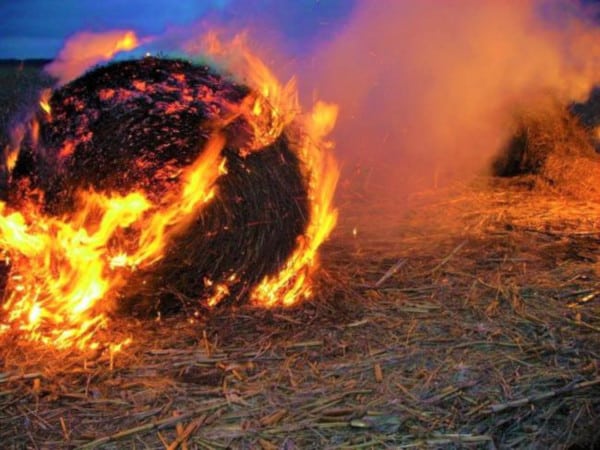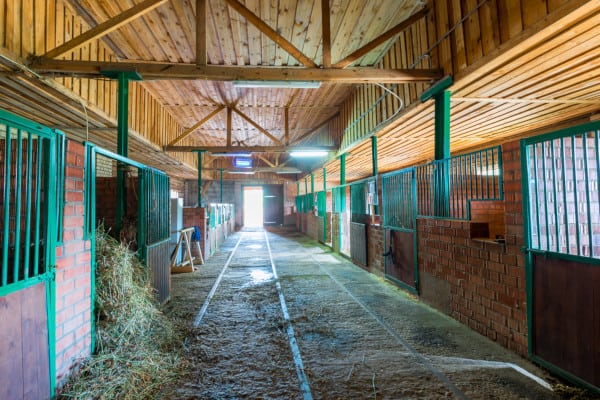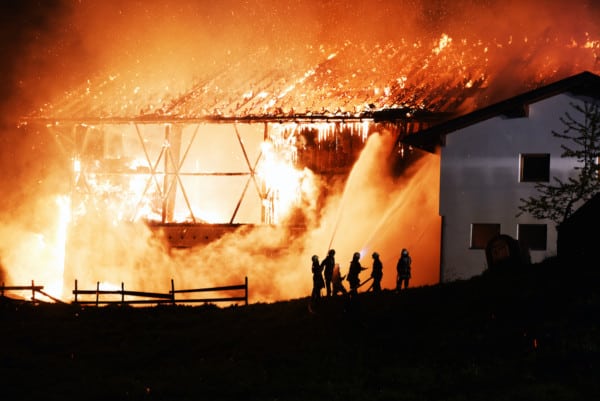NFPA requirements include defining classes and categories and then the need for alarms, automatic sprinklers, and fire extinguishers
Housing horses and other animals is a major component of agribusiness as well as leisure and sports. As such, unchecked fires can have both a huge emotional impact as well as major economic consequences when animals are killed.
Take the community and economy surrounding polo, for example. One of the last remaining sports played purely for the love of the game, the “sport of kings” still relies on a very large economy.
Though polo does involve sponsors, players and teams are often self-funded, with no income-earning potential. A season of polo costs upwards of $3 million dollars. Each game requires eight to 10 horses, as they are switched out anywhere from four to eight times during a single match. The average cost of one of these horses is $45,000. Add these costs to the price of admission and entrance fees, and one can see why this sport is largely relegated to the economic elite of society.
Through their close working relationship, these owners and athletes build a special bond with the horses—as do horse owners and caretakers in a variety of settings. These animals become like family. Stories with headlines like these are hard to read, making adequate fire protection essential to prevent such tragedies:
- “Twenty-four horses die in Connecticut barn fire”
- “Twenty-three horses dead after overnight barn fire”
- “Fire kills dozens of animals at Monticello horse boarding stable”
- “Owner mourns death of 13 horses”
What causes barn and stable fires?
Horse barns and stables have no lack of flammable and combustible materials; many of the items necessary for the housing and care of horses present an inherent fire risk.
These include structural and feeding components such as hay, straw, wood, and grain. Horse-care products like shampoos, liniment, paint, creosote, and alcohol-based products also present considerable risk. They are all easily ignited and burn rapidly.
Leading causes of ignition include smoking materials, electrical issues, and spontaneous combustion of baled hale, the latter of which typically happens when “high moisture hay stacks … cause chemical reactions that build heat.” With the high fire danger and ease of ignitability, it is paramount that proper fire protection precautions are taken.

What are the fire protection requirements for horse barns and stables?
Fire protection measures to safeguard these animals and their housing structures are found in NFPA 150: Fire and Life Safety in Animal Housing Facilities Code. This used to be a “standard” but the 2019 edition brought a complete reorganization, and one of the most significant changes was that it was upgraded from a standard into a code.
Another big change was the creation of additional animal-housing classifications. Where prior editions had two categories (A and B) and three classes (1-3), the new edition has eight categories (1-8) and three classes (A, B, C).
Each category is given its own chapter that outlines specific fire protection requirements, and which points back to the general requirements stated in Chapter 9 of the document. While the document’s structure may have changed, the goals of NFPA 150 remain the same:
From the 2019 edition of NFPA 150
4.1.3.1.1. Safety-from-Fire Goals. The fire safety goals of this Code shall be as follows:
(1) To provide a safe environment for human occupants inside an animal housing facility.
(2) To provide a safe environment for animal occupants inside or adjacent to a structure.
(3) To provide a level of safety for firefighters and emergency responders during search and rescue operations for animal and human occupants.
(4) To minimize loss of property and interruption of facility operations from fire and similar emergencies to a level that is as low as reasonably practical.
To begin to determine what the necessary requirements for your facility are, NFPA 150 leads you to chapter 6, where your structure must be appropriately classified and categorized. The eight categories are:
- Category 1: Animal Health Care
- Category 2: Horse Facilities
- Category 3: Research
- Category 4: Reserved
- Category 5: Exhibition/Public Viewing
- Category 6: General Board and Care
- Category 7: Agriculture
- Category 8: Emergency
Each of these categories may be broken down into classes based on the size of the facility, access by the public, level of human supervision, or whether animal use is commercial or private.
The requirements for fire protection and life safety for horses in barns are outlined in Category 2: Horse Facilities. This category is subsequently broken down into three additional classes based on the facility’s square footage:
- Class A facilities are those greater than 5,000 square feet
- Class B facilities are those smaller than 5,000 square feet
- Class C facilities are small family stables usually housing five or fewer horses owned by the same individual
The fire protection requirements for the larger Class A and B facilities (the former typically defining the space needed for polo facilities, for example) have greater fire protection requirements.
The opening section of chapter 12 requires the user to refer to chapter 42 of NFPA 101: Life Safety Code which covers the fire protection requirements for storage occupancies. These general requirements include various elements such as egress, travel distances, emergency lighting, sprinkler protection, and handling hazardous areas. Chapter 12 of NFPA 150 then moves into the requirements that are specific to horse facilities.

Which life safety systems and components are required in horse facilities?
Fire alarms are required in all Class A facilities and any Class B facility with sleeping quarters. Fire alarm detection devices are required to be installed within all human sleeping areas, any air-conditioned space, and all storage areas that exceed 100 square feet.
Fire sprinkler systems are required in all Class A facilities and any Class B facility with sleeping quarters. Chapter 9 requires a sprinkler system that’s compliant with NFPA 13: Standard for the Installation of Sprinkler Systems and it must utilize quick-response sprinkler heads.
From the 2019 edition of NFPA 150
9.2.3 Quick-response sprinklers shall be utilized in animal housing facilities.
Fire extinguishers must be installed throughout all animal facilities housing horses. A minimum 2-A:10-B:C-rated extinguisher is required at each entrance and within 50 feet of travel.
Additional fire extinguisher selection, location, and maintenance must be in accordance with NFPA 10: Standard for Portable Fire Extinguishers. Due to the abundance of class A fire materials—such as wood, paper, and hay—NFPA 10 requires extinguishers to have a higher Class A rating than the minimum 2-A allowed by certain sections of NFPA 150.
For more detail on fire extinguisher ratings and what they mean, read this blog.

The final NFPA 150 requirement for fire protection and life safety within horse barns and stables is that personnel must be trained. An emergency and disaster plan is required, and employees must be thoroughly trained on the plan. This instruction is to include at least one live drill per year. Additionally, personnel are required to be trained on the proper use of fire extinguishers.
If you are a groom, domestic estate manager, or property owner of a horse facility, you are responsible for the fire protection of the animals under your care—and compliance with the prescriptions in NFPA 150 is the way to do it.
Much of the equipment you will need for compliance—including fire extinguishers and quick response fire sprinklers—is carried by QRFS.
If you have any questions or need help finding an item, contact us at +1 (888) 361-6662 or support@qrfs.com.
This blog was originally posted at blog.qrfs.com. If this article helped you, check us out at Facebook.com/QuickResponseFireSupply or on Twitter @QuickResponseFS.



are fire hydrants required in horses houses
Ghassan — NFPA 150 has sections on fire sprinkler protection, fire detection, alarm, and communication systems, fire and smoke barriers, and fire extinguishers, among other fire protection rules in Chapter 9. But it does not mention hydrants. That said, other codes, whether NFPA or International Code Council, may apply to your situation. You should contact your local authority having jurisdiction (AHJ, usually a fire marshal or building inspector) to determine the specific requirements and fire protection options. Thanks for reading!
Dear QRFS team
thanks a lot for your reply